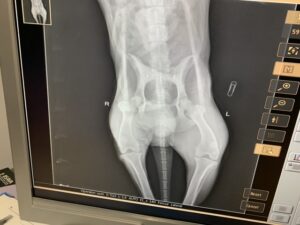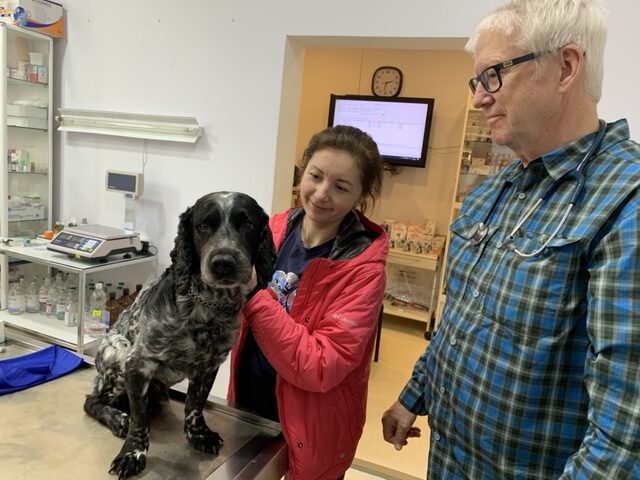Dr. Marty Becker
Imagine people and pets experiencing shelling or bombing, being torn from the familiarity of home, desperately seeking shelter and safety. It’s unthinkable from the perspective of our American homes where most of us luxuriate in safety and comfort, but I met people and pets escaping those experiences when I visited Moldova recently with World Vets, on whose advisory board I serve, to help Ukraine war refugees with pets who needed veterinary care.
Whether in a war-plagued country or Anytown, USA, veterinarians have a sixth sense when it comes to providing care. We need this gift, as pets can’t verbally tell us where it hurts, the discomfort they are feeling such as nausea, or what levels they’re experiencing of fear, anxiety, and stress (FAS) or pain.
FAS in pets and their people is bad enough in an average veterinary visit for routine care. How much worse it must be for these animal refugees who can’t begin to understand what’s happening.
It was late on Saturday when I witnessed the arrival of a displaced family from Odessa, Ukraine. They had traveled about 100 miles to Chisinau, Moldova, to reach safety and to get help for an injured pet at the clinic “Centrul Veterinar.”
World Vets has a longtime working relationship with this top-end practice. A significant number of people with pets needing help are directed there by charity groups on the border or, miraculously, people just seem to sniff it out.
I was in Moldova to assess the situation, unofficially for the American Veterinary Medical Foundation and the World Small Animal Veterinary Association and formally representing the organization I founded, Fear Free, which has a mission to teach and train Fear Free techniques to entire practice teams, with the goal of reducing FAS in all aspects of pet care.
The family I met was Ina Proskurina, a 39-year-old woman, her daughter, whose name I didn’t get, and a 2-year-old 35-pound intact male spaniel mix named Bax, his head bowed in pain and fear.
As a veterinarian with over four decades of practice, I’ve met with clients and patients thousands of times in the eight practices I’ve had ownership in. While I’ve trained veterinarians in over 90 countries on how to do the rehearsed but constantly evolving dance of a physical exam and consultation, I’d never done this for real in another country.
Veterinarians in Romania and Moldova do not use veterinary technicians like we do in North America to assist us in exams. I was on my own.
Lowering myself to the tile floor so I was at eye level with the woman and beside the dog, I introduced myself.
Those of us who embrace and practice Fear Free know that we can’t just focus on a pet’s physical wellbeing while ignoring their emotional wellbeing. I had two important tools to use in my comprehensive examination and consultation: a stethoscope and a foil package of really tasty wet dog food. Rather than put the dog up on a cold, slippery exam table to do the exam, I got down on the floor on my knees.
Bax showed several signs of high levels of FAS:
1) Rigid, not relaxed
2) Panting
3) Yawning
4) Lip licking
5) Shaking
6) Furrowed brow
7) Ears and tail pinned
8) Avoiding eye contact
As veterinarians, we should never perform a procedure on a panicky, stressed pet. Before I took the history and started the examination of Bax, I knew I had to bring his FAS levels down. Bax was on the thin side and he’d traveled quite a distance, so I expected he’d respond to food rewards. In Fear Free we call it “Putting the treat into treatment.”
I peeled back the foil covering a small tray of gourmet dog food and let Bax take tiny licks of the tasty food. Near instantly, he stopped shivering, shaking, panting, and yawning as his taste buds overpowered the “fight or flight” response.
My stethoscope had been cleaned with Rescue, a unique biosecurity product I’d brought from home. Rescue is a unique formula of H2O2 (hydrogen peroxide) that breaks down into water and oxygen. No harsh toxic chemicals.
I wasn’t using Rescue to kill any bacteria, viruses, or fungi as much as to remove any fear pheromones that might be on the surface, potentially increasing Bax’s FAS.
After cleaning, I wiped the stethoscope with Adaptil, a synthetic version of the dog-appeasing pheromone, what the mother dog, or bitch, uses to keep her nursing babies calm so as not to alert predators. I was wearing the same pheromone on my pants and shirt.
This pheromone works throughout a dog’s life and after a few whiffs makes them feel like they’ve had two glasses of wine and a Valium. Put another way, it takes them from “Uh oh” to “Ahhhhh.”
Now I was ready to find out what was going on with Bax. Ina and her daughter explained that as they made their way to Moldova, Bax had started limping on his right rear leg, becoming less active. For the last month, his appetite, bathroom habits, and basic attitude had been the same, but the lameness wasn’t improving. And Bax was family. They didn’t want him to suffer if they could do something to make him better. Bax was important to the family’s wellbeing and recovery.
If Bax was healed, it would help them heal.
I told Ina that I was going to examine the right rear leg last, so that I didn’t miss anything. I didn’t want her to think that I hadn’t listened to her describe the presenting problem.
 I hit the same well-practiced rituals of exam I’ve done thousands of times:
I hit the same well-practiced rituals of exam I’ve done thousands of times:
1) I let Bax sniff the stethoscope then put it back around my neck. Through the pheromones, he smelled his mama, and that calmed him.
2) On the head, I check the nose for discharge, mouth for periodontal disease, and ears for infection. I also check the eyes for signs of ulcers, extra eyelashes, plugged tear ducts, cataracts, etc.
3) Starting with the mandibular lymph nodes, I palpated all sentinel nodes for signs of infection or cancer.
4) Moving to the chest, I auscultated the heart and lungs.
5) Next I check the paws and nails, feel the outside of the two front legs and put each joint through a full range of motion.
6) Then my hands slip down the full curvature of the posterior chest to the abdomen, where I squeeze and palpate the liver, spleen, kidneys, and bladder, as well as the penis in a male.
7) I examine both back legs the same way I do the front.
8) I then lift the tail and check around the anus and vulva if we have a female.
9) I run my hand down the full length of the tail.
10) Finally, I use both thumbs and rub on each side of the vertebral processes of the back from the base of the skull to the base of the tail to check for spinal cord pain.
While I didn’t have blood work to check the function of the internal organs, I didn’t find anything outwardly wrong with Bax. Now it was time to check the right rear leg lameness they brought him in for.
We decided to radiograph the leg to see if there were any fractures to the bones of the hip and leg. Startling fact: In Moldova, a country of 3.5 million people, “Centrul Veterinar” is the only veterinary practice with an x-ray machine.
 We gave Bax an intramuscular injection of a drug to calm him and took two views of the leg.
We gave Bax an intramuscular injection of a drug to calm him and took two views of the leg.
There was no pathology to any of the bones. Now thinking that the anterior cruciate ligament was only strained, not torn, we decided to give Pax an injection of an analgesic for pain, send him home on oral painkillers and recheck him in a week.
I walked outside with Ina, her daughter, and Bax. We talked for a while before they left to go back to their temporary home in Chisinau. Ina started to cry softly as they described the damage to their neighborhood and the desire to go back to her husband and home.
Damaged or not, home was where the heart wanted to return.
She said since the war had started and they had fled to Moldova, Bax had started sleeping in the bed with her, something her husband had forbidden before. Wiping away tears and cracking a grin she said, “My husband has already told me that he’s fine sharing the bed with both Bax and me when we’re together again.”
I smiled and nodded, but looking at them I wondered, “Will the husband/father survive fighting the Russians? Will that promise of all sleeping together be a reality?”
I’d done all I could do for them as a veterinarian, concerned volunteer, and I hoped new friend. It was out of my hands as I was leaving Moldova the next day. The veterinarians at “Centrul Veterinar” would take excellent care of them, even if Bax needed surgery.
World Vets was covering all costs.
As I watched them leave, I thought of something I’ve said for decades: “There truly is only one greatest pet in the world … and every family has him or her.”
It’s in your hands now, Heavenly Father.
We have a fund-raising goal of $15,000 for World Vets. Funds raised will be used for veterinary supplies and direct veterinary care of pets from Ukraine, including those in shelters, over the coming weeks and months. Their financial support allows local veterinarians in Moldova and Romania to provide care for Ukraine pets. In addition, World Vets is in the planning stages to send a veterinary team for a large-scale sterilization and medical consult campaign at Sava’s Safe Haven in Romania. This campaign will include parasite treatment, health checks, deworming, and any medical and surgical consults needed to address health issues. Veterinary teams volunteer their time and cover their own travel expenses. If you would like to help carry on this work, you can donate to World Vets here: https://worldvets.org/2022/03/helping-pets-from-ukraine/
This article was reviewed/edited by board-certified veterinary behaviorist Dr. Kenneth Martin and/or veterinary technician specialist in behavior Debbie Martin, LVT.




